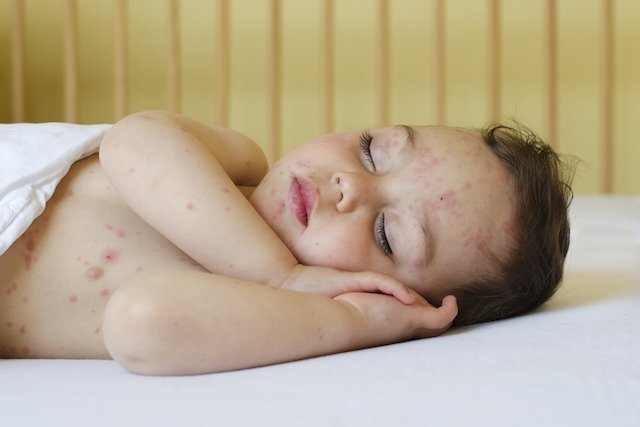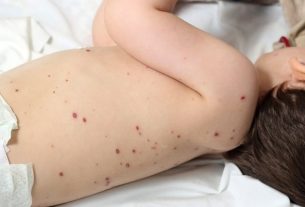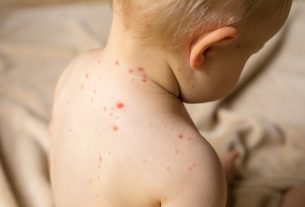Chickenpox in babies is an infectious disease that leads to the appearance of red bumps on the skin that are very itchy.
Chickenpox is most common in babies and children up to 10 years of age and can be easily transmitted through contact with the liquid released by the blisters or through inhalation of respiratory secretions that remain suspended in the air when a person with chickenpox coughs or sneezes.
Chickenpox treatment is aimed at relieving symptoms, and the pediatrician may recommend the use of medication to reduce fever and relieve itching. It is important that a child with chickenpox does not burst the blisters and avoids contact with other children for around 7 days, as this will prevent transmission of the virus.

Chickenpox symptoms in baby
The main symptoms of chickenpox in babies are:
- Small reddish dots/blisters on the skin;
- Fever;
- Itchy skin;
- Easy crying;
- Decreased desire to eat;
- Discomfort and irritation.
Generally, chickenpox blisters initially appear on the chest and then tend to spread to the arms and legs, causing small wounds.
It is important that a child suspected of having chickenpox is taken to the pediatrician as soon as the first signs appear, and it is also recommended that they do not go to daycare or school for around 7 days or until advised by the pediatrician.
How transmission happens
Chickenpox transmission can happen through saliva, sneezing, coughing or contact with objects or surfaces contaminated by the virus. Furthermore, the virus can be transmitted through contact with the liquid released from blisters when they are burst.
When the child is already infected, the virus transmission time lasts, on average, 5 to 7 days and, during this period, the child should not contact other children. Furthermore, children who have already had the chickenpox vaccine may also get the disease again, but in a milder form, with fewer blisters and low fever.
How the treatment is carried out
The treatment of chickenpox in babies must be carried out in accordance with the pediatrician’s guidance and aims to alleviate symptoms and reduce discomfort in the baby, and it is recommended:
- Cut baby’s nailsto prevent it from scratching and bursting blisters, avoiding not only wounds but also the risk of transmission;
- Apply a wet towel in cold water in the most itchy areas;
- Avoid sun exposure and heat;
- Dress light clothesas sweat can make itching worse;
- Measure the baby’s temperature with a thermometerto check if you have a fever every 2 hours and give medicine to reduce the fever, such as Paracetamol, as recommended by your pediatrician;
- Apply ointments on the skin as recommended by a doctor, such as Povidone.
Furthermore, it is recommended that the baby does not have contact with other children to avoid transmitting the virus to other children. Furthermore, one of the most effective ways to prevent chickenpox is through vaccination, which is offered free of charge by the SUS and is recommended for babies aged 12 months and over. See more about chickenpox treatment.
When to go back to the pediatrician
It is important to go back to the pediatrician if the baby has a fever above 39ºC, even when using the medications already recommended, and the skin is red. It is also recommended to consult a pediatrician when the itching is intense and prevents the baby from sleeping. or when infected and/or pus-filled wounds appear.
In these cases, it may be necessary to take medication to relieve itching and treat wound infection, which is why it is important to go to the doctor so that he or she can prescribe antiviral medications, for example.
Bibliography
- BRAZILIAN SOCIETY OF DERMATOLOGY. Chickenpox. Available at: <https://www.sbd.org.br/dermatologia/pele/doencas-e-problemas/catapora/65/>. Accessed on February 4, 2020
- MINISTRY OF HEALTH. Chickenpox (Varicella): causes, symptoms, diagnosis, treatment and prevention. Available at: <http://saude.gov.br/saude-de-az/varicela-catapora>. Accessed on February 4, 2020

Sign up for our newsletter and stay up to date with exclusive news
that can transform your routine!
Warning: Undefined array key "title" in /home/storelat/public_html/wp-content/plugins/link-whisper-premium/templates/frontend/related-posts.php on line 12
Warning: Undefined array key "title_tag" in /home/storelat/public_html/wp-content/plugins/link-whisper-premium/templates/frontend/related-posts.php on line 13



